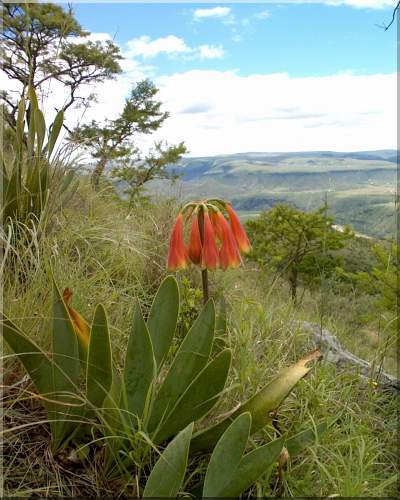

Cyrtanthus obliquus Dec2001. Image by![]() Cameron
McMaster
Cameron
McMaster
| Cyrtanthus are endemic to South Africa of which there are
approximately 50 species. These bulbous plants are very diverse in
flower, bulb type and cultivation requirements. One could spend an
entire lifetime growing this genus exclusively with continual
satisfaction/expanding knowledge of bulbs and their requirements. Growing
Cyrtanthus can be a tricky business indeed. To quote most avid Cyrtanthus collectors, this genus includes some very easy to cultivate species. However, there are many species that are hard, if not difficult, to cultivate. C. spiralis is very sensitive to water in the medium and C. obliquus is known for its resistance to home cultivation. I have transplanted C. obliquus out into the open garden, in heavy clay/sand soil and the results look promising. Reputedly, C. obliquus die after 4-5 years growing, not long before flowering. This can be frustrating for many gardeners. Proper study of this genus, corresponding with fellow Cyrtanthus growers and careful observations in mediums used are all good ingredients for the Cyrtanthus collector. Naturalists', such a Cameron McMaster, add greatly to the collective knowledge bank of Cyrtanthus collectors. I find his field observations essential reading for any avid Amaryllid grower.
Cyrtanthus obliquus
Keilandscape. Image by
Very
difficult species like Cyrtanthus spirals need to have a large amount of
course gravel into their mediums for excellent drainage. Cultivating
in Pots: C. spiralis, C. helictus, C. herrei and C. montanus are
species that have specific needs in their medium requirements. Fill the
pot that you are using 1/2 way with broken bricks or large stones. Cover
this with a 1-inch stone to seal the large air holes and stop the medium
from falling through. Them, using a mix of 3 Parts Orchid bark (5-10mm),
2 Parts sharp sand and 1/4 part leaf mulch (composted), pot on your
bulbs as usual. Keep in mind that many species like to be planted with
at least 1/2 the bulb showing. If they want to go deeper, they will do
this on their own. These 4 species also need more sun light/less shade
to do well. Place the pots where there is plenty of airflow. Feeding is by composted cow manure. I spread a light application of this at the start and during the growing season. This can also be added as a liquid fertilizer, soaking the composted manure in water for a couple of days before use. Cyrtanthus elatus
14Jan.
Image by We have Cyrtanthus species and hybrids growing here at Mainly Amaryllids Garden and we are keen to expand this genus in the enthusiast's collection. These bulbs will be listed as they become available. I am doing trails now to see what species will grow here at Barnawartha. Happy
gardening, Dash. |

Cyrtanthus falcatus Sep16.
Image by
![]() Cameron
McMaster
Cameron
McMaster
|
-------------------------------------------------------------------------------------
------------------------------------------------------------------------------------- |
![]() Order
Wild Bulbs of the Eastern Cape disk
Order
Wild Bulbs of the Eastern Cape disk
![]() Home
Home